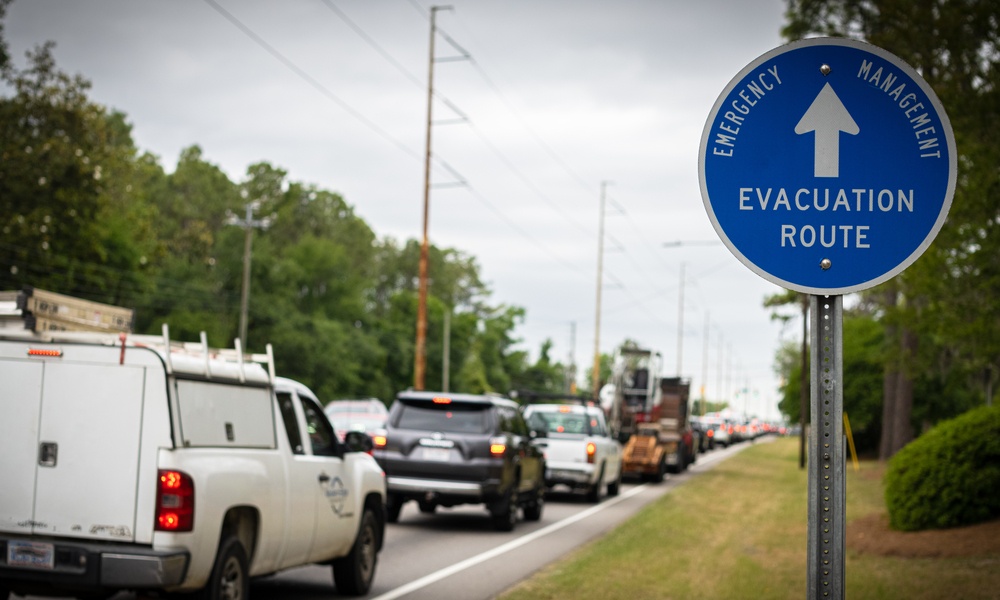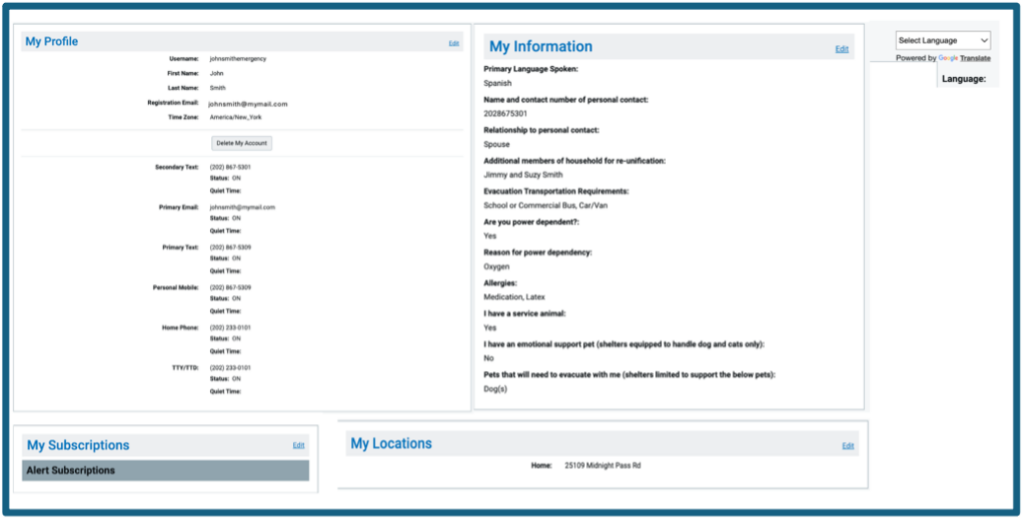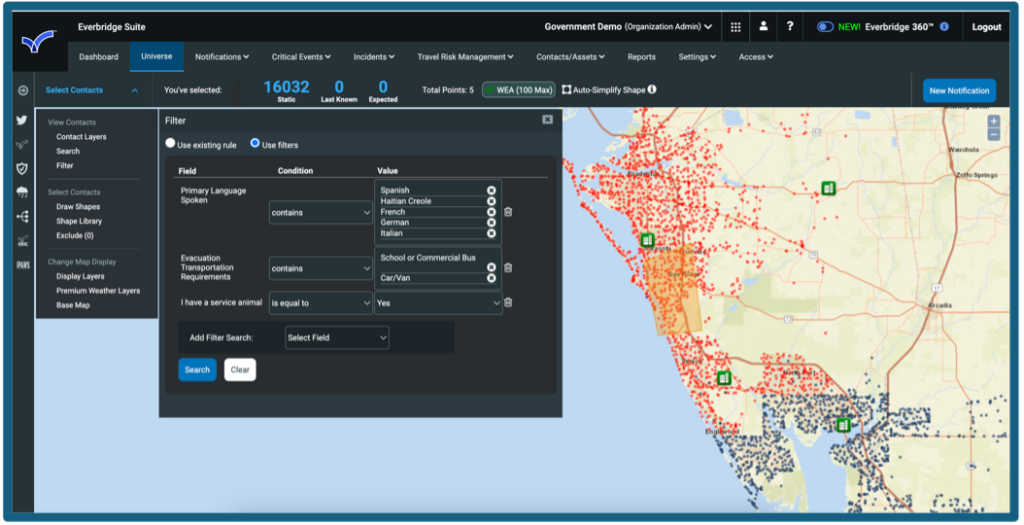Enhancing inclusive emergency communication: Addressing access and functional needs communities amid disasters

By Brian Toolan, Vice President, Public Safety, Everbridge
In times of crisis, effective communication is critical to ensuring the safety and well-being of all individuals in our communities. However, traditional communication methods may not adequately reach or cater to the needs of those with access and functional challenges. It’s imperative that emergency communication strategies are inclusive and considerate of the diverse needs of every member of society. In this blog, we’ll explore two concepts, the importance of tailored emergency communication for access and functional needs communities and the need to transform and visualize data into actionable insights.
Access and functional needs encompass a wide range of requirements that individuals may have during emergencies. This can include people with physical disabilities, sensory impairments, cognitive limitations, language barriers, or other conditions that affect their ability to receive and understand emergency information. It’s crucial to recognize that these individuals may require additional support and accommodations to effectively navigate emergency situations and make informed decisions.
Gathering this information presents one of the most significant hurdles that emergency officials face. A comprehensive emergency communications solution not only aids in community engagement but also equips emergency officials with the necessary resources to deliver effective communications to those who require assistance. The capacity to effectively utilize the gathered data can be a matter of life and death, ensuring comprehensive inclusivity and leaving no individual overlooked.
Fostering partnerships between public agencies, private organizations, and community stakeholders improves emergency communication for access and functional needs communities. Working together to develop and implement inclusive communication plans, share resources, and coordinate efforts ensures that everyone receives timely and relevant emergency information and assistance.
Challenges in emergency communication
Traditional methods of emergency communication, such as sirens, text alerts, or televised broadcasts, often don’t adequately meet the needs of access and functional communities. Individuals with disabilities or sensory impairments may face barriers in accessing information presented in audio or visual formats, while those with limited English proficiency may struggle to understand messages delivered in a language they do not speak fluently. Moreover, individuals with mobility challenges may encounter difficulties in accessing physical evacuation routes or emergency shelters.
Strategies for inclusive emergency communication
- Multi-Modal communication: Adopt a multi-modal approach to emergency communication that caters to diverse communication preferences and needs. This may include utilizing phone, email, and text-based alerts, visual graphics, video messages with sign language interpretation, and audio descriptions to ensure that information is accessible to individuals with different sensory abilities.
- Language accessibility: Provide emergency information in multiple languages to accommodate non-English speakers and individuals with limited English proficiency. Translate written materials, broadcast messages, and digital content into languages commonly spoken within the community to ensure that everyone can understand and respond to emergency alerts and instructions.
- Accessible communication channels: Ensure that emergency communication channels and platforms are accessible to individuals with disabilities. This may involve offering alternative formats for digital content, such as screen reader compatibility for websites and mobile apps or providing video messages with sign language interpretation or TTY/TDD services for individuals with hearing impairments.
Community empowerment: Foster meaningful engagement
To ensure inclusive emergency preparedness and planning, it’s vital to actively engage with access and functional needs communities. This involves consulting with disability advocacy groups, senior centers, and various community and social organizations to gain a deeper understanding of the specific needs and preferences of diverse populations. By involving these groups in the development of inclusive communication strategies, emergency managers can create more effective and responsive plans.

Furthermore, empowering the leaders of these community groups plays a crucial role in the enrollment of people with access and functional needs. By providing them with the tools, resources, and support they need, these leaders can effectively reach out to individuals within their communities, ensuring that no one is left behind in emergency preparedness efforts. This collaborative approach fosters trust, inclusivity, and resilience within the community, ultimately enhancing overall disaster response capabilities.
Transforming data into actionable insights:
After overcoming the challenge of enrollment and gathering access and functional needs data, emergency managers face the critical task of making this data actionable. But how can they accomplish this? The collection process often reveals vital information, including:
- Primary address of residence
- Preferred communication modalities
- Primary language spoken
- Name and contact information for a personal contact
- Willingness to evacuate when orders are issued
- Transportation requirements for evacuation
- Dependency on power
- Required medications during evacuation
- Presence of pets
- Possession of a service animal
However, simply collecting this data is not enough; it must be transformed into actionable insights to effectively support emergency response efforts.
Instantaneous visualization of community needs: A crucial capability for emergency managers
Emergency managers face the daunting task of rapidly assessing and responding to community needs before, during, and after disasters. In this endeavor, the ability to swiftly visualize the diverse needs of the community is paramount. However, this task is not without its challenges. Filtering through vast amounts of data is essential not only for visualizing community demographics but also for triggering timely alerts based on factors collected during enrollment. By leveraging advanced data visualization tools and filtering mechanisms, emergency managers can gain invaluable insights into the unique requirements of their communities. Here’s why this capability is indispensable:
- Real-time Decision Making: During crises, every second counts. Emergency managers need to make quick and well-informed decisions to effectively allocate resources and coordinate response efforts. Instantaneous visualization of community needs enables them to identify priority areas and deploy resources where they are most needed, ensuring a swift and targeted response.
- Tailored Communication and Alerts: By filtering through enrollment data and creating actionable rules, emergency managers can quickly identify vulnerable populations, such as individuals with disabilities, those who require power to keep medication from spoiling or require oxygen to breathe easier, seniors, or non-English speakers, and tailor communication and alerts to meet their specific needs. This ensures that critical information reaches everyone in a timely manner, enhancing overall community resilience.
- Resource Allocation: Understanding the demographics and needs of the community allows emergency managers to allocate resources more efficiently. Whether it’s setting up accessible shelters, providing medical assistance, or arranging transportation for evacuation, having a clear visualization of community needs enables strategic resource allocation to address diverse requirements.

- Post-Disaster Recovery: Visualizing community needs doesn’t end when the disaster subsides. Post-disaster recovery efforts also rely on accurate and up-to-date data to assess the extent of damage, prioritize recovery initiatives, and support affected communities. By continuously monitoring and visualizing post-disaster needs, emergency managers can facilitate a smoother recovery process and aid in rebuilding efforts.
To achieve this capability, emergency managers must invest in robust data management systems, analytics tools, and communication platforms. These technologies enable them to collect, analyze, and visualize data in real-time, empowering them to make informed decisions and take proactive measures to safeguard their communities. The ability to instantly visualize community needs and filter data effectively is indispensable for emergency managers. By leveraging advanced technologies and data-driven approaches, they can ensure a more targeted, efficient, and inclusive response to disasters, ultimately enhancing community resilience and well-being.
Conclusion
Inclusive emergency communication is a fundamental aspect of disaster preparedness and response, ensuring that all individuals, regardless of their abilities or limitations, have equal access to life-saving information and support services during emergencies. By recognizing the diverse needs of access and functional communities and implementing tailored communication strategies, we can bridge the gap and create more inclusive and resilient communities that are better equipped to respond to disasters. Providing emergency managers with the necessary tools to proactively utilize location intelligence, facilitates the rapid deployment of communication strategies to affected areas. This ensures that messages are comprehensible and actionable, thus enhancing overall response effectiveness.
Together, let’s strive to ensure that no one is left behind in times of crisis.


